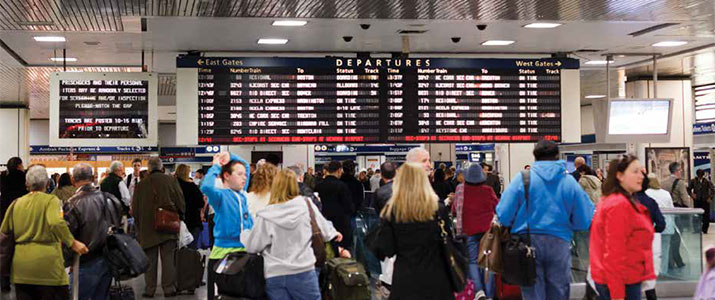
All Aboard
One of the world’s busiest train stations is fully protected
- By Peter Ebersold
- Mar 01, 2013

It took a full two years to commission a massive network of three fire alarm
control panels, 53 subpanels and more than 2,600 devices throughout 550
rooms, tunnels and platforms within one of the world’s busiest commuter
hubs. In additional to sprinkler monitoring, the system integrates with a
number of ancillary building systems to perform code-required controls of
escalators and elevators, plus fans for smoke control. Thanks to some savvy engineering
and state-of-the-art technology, this 50-year-old, New York City train
station is now outfitted with a single, integrated fire alarm and emergency communications
system.
Installation and Control
A major challenge was the execution of this momentous installation without
disruption to the station’s daily 20-hour train service and the more than 250,000
people that pass through each day.
“Basically, we only had four-hour windows in the middle of the night where
we could work trackside when the trains were not present,” said Bob Farm, sales
engineer, United Fire Protection Corp. (UFP), the Kenilworth, N.J.,-based NOTIFIER distributor that provided and installed the major systems on the project.
Incorporating the owner’s requirements for a proven system, offering multiple
layers of flexibility and an easy means of monitoring and control, Code Consultants
designed the system as an open specification, which was put out to bid.
“The electrical contractor and United Fire’s team, along with their plan to
complete the project, was what really sold the job,” said William J. Aaron, Jr., the
system designer and senior project manager with Code Consultants in St. Louis.
“In addition, the company had the support system to get the equipment to the
distributor (UFP) on time, and to provide help in the field when it was needed.”
Using a combination of fiber optic and copper wire for networking, UFP went
with Class A, Style 7 circuitry, which provided a high level of survivability.
“Because we were able to install subsystems and
amplifiers throughout the facility, we were able to
keep home run wiring to a minimum,” Farm said.
According to the station’s engineering fire and life
safety project manager, the system’s ability to network
multiple panels that distribute the power and control
capabilities throughout the station, enable protection
for a large facility, with a myriad of conditions, to operate
as one overall system.
The entire fire alarm and emergency communications
system is monitored and controlled from three
different command centers—two onsite and one in
another state. Staffed 24/7, each command center
comprises a digital voice command panel (DVC),
used to monitor the entire fire alarm network. The
DVCs are equipped with a microphone and enable
live voice announcements and temporal evacuation
tones through the facility’s hundreds of speakers or
to any of its five notification zones.
To heighten monitoring and control of the network,
the primary onsite fire command station also
is equipped with a NOTIFIER ONYXWorks graphic
workstation, providing floor-by-floor views of the entire
facility and its major fire alarm and emergency
communications system components. Through simple
virtual switches programmed to perform a number of
functions, ONYXWorks can control fans and other
major network components. For example, specific
smoke detector zones can be temporarily shut down
for maintenance or when welding is taking place within
a particular area.
Given the variety of environments and ambient
noise commonly present throughout the station, the
audio quality of announcements had to be highly intelligible.
Farm refers to this system’s audio as being
“of CD quality.” Similarly, the visual notification had
to be ADA-compliant.
Whether signaling a possible fire or highlighting
the importance of emergency notifications, the system’s
strobes can be used for both fire alarm and mass
notification events.
“The day we turned that system on, which required
synchronizing more than 1,000 strobes, and
saw the synchronized strobes flashing across all of
the train platforms—that was quite an amazing
sight,” Aaron said.
In terms of going with one unified fire alarm and
emergency communications system, the station’s
engineering fire and life safety project manager explains
that it was really a no-brainer due to cost savings,
reduced power requirements and more effective
operations.
With so many components and such complexity
built into the system, the technology’s modular flexibility
enabled the team to bring parts of the system
on-line as they were completed.
“We had to build this thing in pieces and do the
final hook-up in the end, because we could pre-test
each component as we went along,” Farm said.
Creative Engineering
Conventional smoke and heat detection devices were
installed in most of the terminal areas. However, areas
presenting a challenge for detector installations
included space comprising ceilings with too many
obstructions, in high-voltage substations and on the
train tracks themselves where overhead high-voltage
catenary power lines could not be shut down.
Linear heat detection cable offered a great solution
for utility rooms and substations were fitted with
beam detectors, serving to keep transmitters and receivers
away from high-voltage equipment.
As for the train platforms, engineers had to get
a little more creative. Considering the trains travel
through environmental extremes without any means
of separation, the facility had to be prepared for any
emergency situation brought about by an incoming
train.
“For that application, we used a technology used
in Europe, but new to the United States that is fiberoptic
linear heat detection,” Aaron said. “To keep the
electricians away from those overhead power lines on
the tracks, we used fiberglass conduit because it’s not
conductive, as opposed to steel.”
To integrate the train platforms’ heat detection
with the NOTIFIER system, the engineers established
output contacts from the subpanels, and using
monitoring modules, they sub-divided the outputs to
be monitored through the central fire alarm panel.
Another important aspect of this fire alarm and
emergency communications system was the ability to
adapt easily to future changes and expansions.
“We were looking for a system that would not
only cover the building now, but give the owners the
flexibility that whatever happens in the future, we
could incorporate more functionality into the system,”
Aaron said.
Reflecting back on the project that dominated
two years of his life, Aaron recalls the thrill of turning
on the entire system.
“It was quite humbling to see a
project of this scale perform exactly
as it was designed.”
This article originally appeared in the March 2013 issue of Security Today.